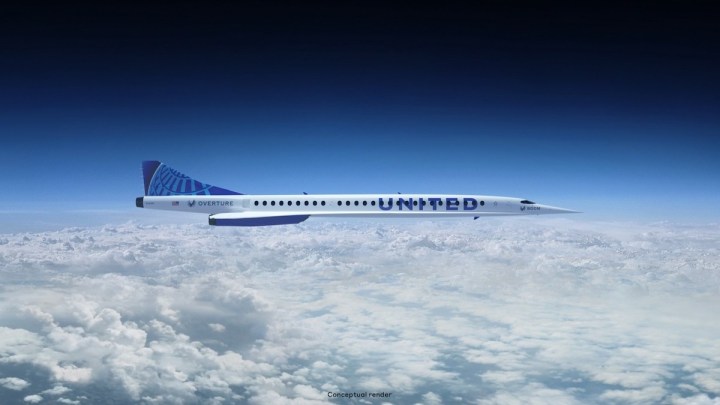
The return of supersonic passenger travel took a significant step forward this week after United Airlines announced a plan to purchase 15 aircraft from Boom Supersonic.
The agreement between the two companies will see United purchase 15 of Boom’s under-development Overture aircraft so long as the high-speed jet meets particular safety, operating, and sustainability requirements. United, which also has an option to buy a further 35 Overture planes at a later date, wants to put the aircraft into commercial service in 2029.
Introducing the United supersonic fleet.@United will purchase up to 50 Overture airliners and fly the fleet on 100% sustainable aviation fuels. https://t.co/zVG2aMCVKx #BoomSupersonic pic.twitter.com/kg9eoFT2Ww
— Boom Supersonic (@boomaero) June 3, 2021
Colorado-based Boom is yet to build a working version of Overture, though last October it unveiled a smaller prototype called the XB-1 that’s set to take its maiden flight later this year.
Overture is designed to carry up to 75 passengers and fly at speeds of Mach-1.7. That’s just over 1300 mph, or twice the speed of today’s fastest airliners.
That means Overture will be able to fly from, say, Newark to London in three-and-a-half hours, Newark to Frankfurt in four hours, and San Francisco to Tokyo in six hours — in some cases slashing the usual journey time in half.
Mindful of air travel’s impact on the environment, Boom is aiming for Overture to become the first large commercial aircraft that’s net-zero carbon, optimized to run on 100% sustainable aviation fuel.
“A stellar flight experience”
“United continues on its trajectory to build a more innovative, sustainable airline and today’s advancements in technology are making it more viable for that to include supersonic planes,” United CEO Scott Kirby said as part of this week’s announcement. “Boom’s vision for the future of commercial aviation, combined with the industry’s most robust route network in the world, will give business and leisure travelers access to a stellar flight experience.”
Blake Scholl, founder and CEO of Boom Supersonic, said the two companies share a common purpose “to unite the world safely and sustainably.” Scholl added, “At speeds twice as fast, United passengers will experience all the advantages of life lived in person, from deeper, more productive business relationships to longer, more relaxing vacations to far-off destinations.”
United isn’t the first major carrier to show an interest in Boom’s technology, with Japan Airlines and the U.K.’s Virgin Group already having signed deals for a total of 30 Overture jets.
With this latest deal, Boom is edging toward launching the first supersonic passenger service since Concorde’s last commercial flight in 2003, but routes for the next-generation supersonic aircraft will likely be limited. This is because many countries ban jets from flying faster than the speed of sound to prevent the disruptive sonic boom. In other words, Overture may be limited to coastal airports, with flights heading out across the ocean rather than inland.
Ticket prices may be out of reach for many travelers, too. While airlines will have the final say, Boom says it expects carriers will be able to offer fares at business-class prices — much pricer than seats in coach.


